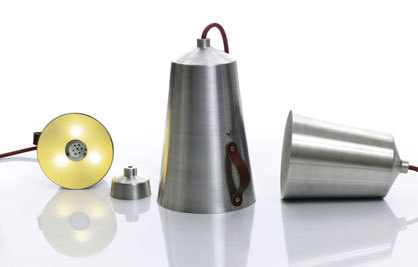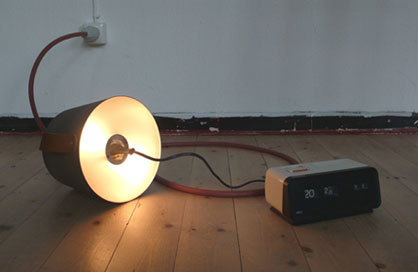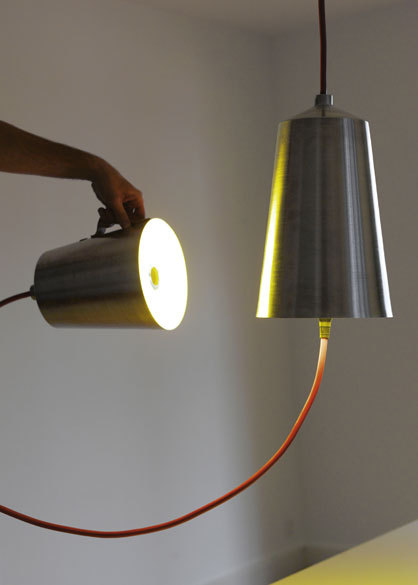'Design has to be fun...'
Texto por Line Numme
Zürich, Suiza
29.01.09
An interview with the ambitious and talented german designer Sebastian Herkner.
Sebastian Herkner, the 27-year old German designer, studied product design at the Academy of Art and Design Offenbach am Main. Since graduating in 2007 he has also a teaching assignment at the Academy and after setting up his own studio he's well on the way to making a career in the world of design. In November we got to know him at the 'YDMI 2008' - Young Designers Meet The Industry' forum, which was organised in Berlin by the 'Rat für Formgebung' (German Design Council). He was one of the five Young Professionals nominated for the YDMI prize.
Should we look at your 'nan16' lamp with a certain amount of irony? Formally and in its functions it makes a very utilitarian impression, and with its simple metal shade, leather strap and prominently visible reddish-brown cable it's a little reminiscent of industrial lamps from the Thirties. What's the background to this design?
The design is based on the finding that the nearest source of power on a desk or even a dining table is the lamp above it. nan16 makes it possible to connect a toaster or a notebook simply and conveniently, without having to crawl around on the floor underneath the table. The association with a workplace light fixture is deliberate, because in addition to its function of spreading light, it is also a means of power distribution. The design of the lamp shows my close interest in materials, production and technology. I have here combined the very traditional craftsmanship of metal spinning with innovative details such as laser engraving on the rivets of the leather handle.
This idea seems to be going in a completely opposite direction as the current trend towards doing without cables as much as possible. In contrast you almost make the cable a main component of the lamp. How do you see this?
When you swim against the stream the turbulence that this creates sometimes provides the new potential for a product like this lamp. You can either hide the cable awkwardly and artificially, or you can make it part of the design and a kind of emblem.
How did the cooperation with the Swiss firm 'nanoo' come about which is producing your lamp now?
I presented the prototypes of the lamp as part of the Talents at Tendence in Frankfurt am Main in July. This led to initial contact with Pascal Kesseli, the manager of 'nanoo', which was followed by a further discussion shortly after the fair in Wil near Zurich. We then presented it for the first time at Interieur08 in Kortrijk.
You've now designed a number of lamps. Are you planning to continue working with the theme of lighting in future?
This is definitely one of the focal points of my work, but at the moment I'm also working very much in the area of classical product and exhibition design. I don't want to place too many limits on myself - instead I'm aiming at designing products in the broad sense which prove themselves useful in all aspects of everyday life, based on my own observation and experience, as well as on interdisciplinary influences.
'Silhouette' by Sebastian Herkner, shown at the imm cologne 2009
I've heard that in April you are going to be exhibiting at 'Satellite' in Milan for the first time. What significance does this have for you, and what expectations do you have?
Whenever the time is available I try to present myself and my products at exhibitions on a regular basis, because direct contacts and a critical dialogue with industry, the press and the customer are possible there. 'Satellite' is sure to be a very special event, especially as I'll be taking part as an exhibitor for the first time. However, the nan16 lamp shows that the potential and the quality of a product are more important than the size and profile of an exhibition.
That's the way I see it, too. Using exhibitions as a forum for contacts definitely continues to make sense, especially as there aren't too many alternatives. One of these was the recent YDMI event in Berlin, in which you were involved, too. What's your opinion of this kind of 'recruiting platform'?
I find that what events like the YDMI days organised by the 'Rat für Formgebung' have to offer is useful and exciting. During these three days we were able to develop our contacts with designers we knew from other exhibitions, and at the same time establish new contacts with representatives from business, the press and industry. The latter were not represented in the kind of numbers I would have hoped for – above all contacts from the furniture and lighting industries would have been interesting.
I've noticed that more and more up-and-coming designers are getting together to form 'design collectives', in order to make shared use of resources and have more influence on a highly competitive market, instead of trying to succeed on their own. Would that be an option for you, too, or do you prefer working on your own?
As a matter of fact I'm currently working on my own individual projects and cooperating on projects with the designer Reinhard Dienes, with whom I'll be exhibiting at the coming Salone Satellite 09. Depending on the scope of the project and the range of your own interests this is a good way of using resources and know-how in an effective and targeted way. In the long term it would definitely be an interesting option to think about some kind of flexible design formation, in which interdisciplinary projects can be implemented.
Thank you for talking to us, and best wishes for the future!







